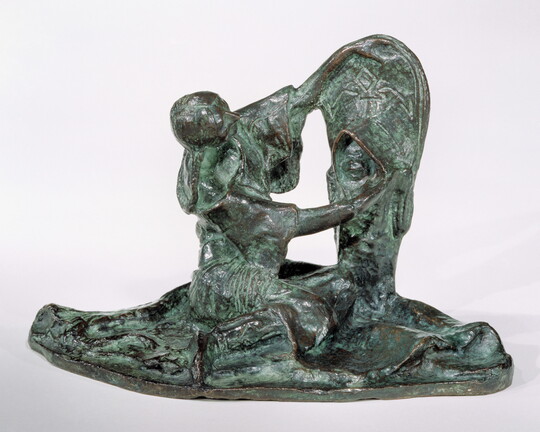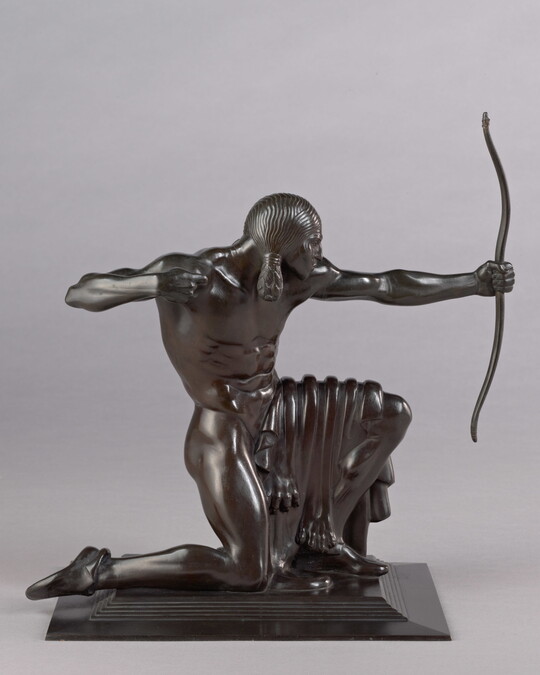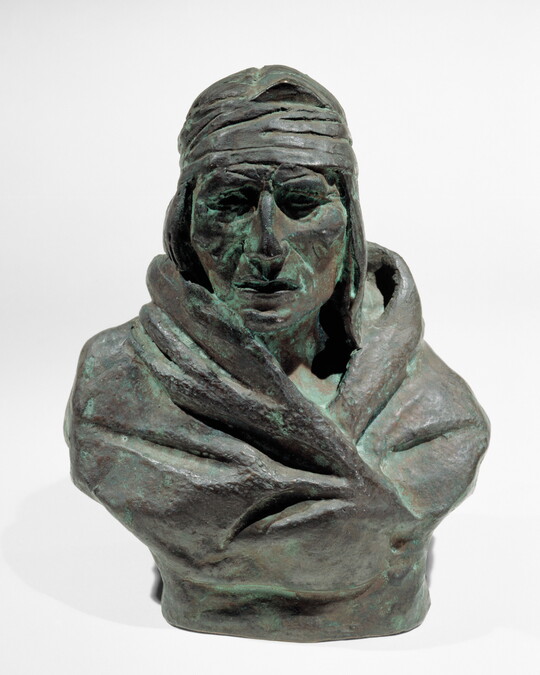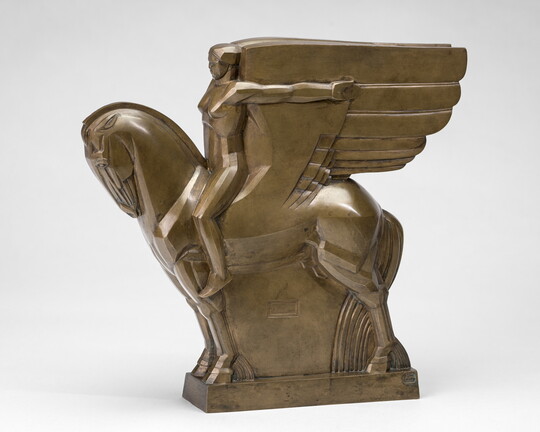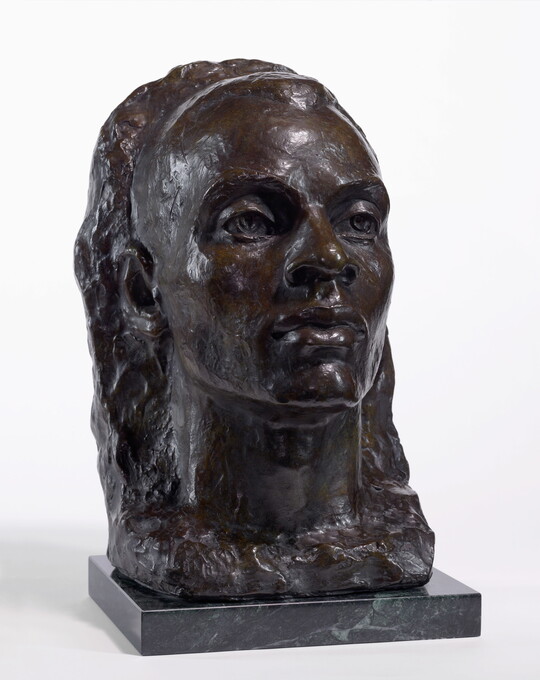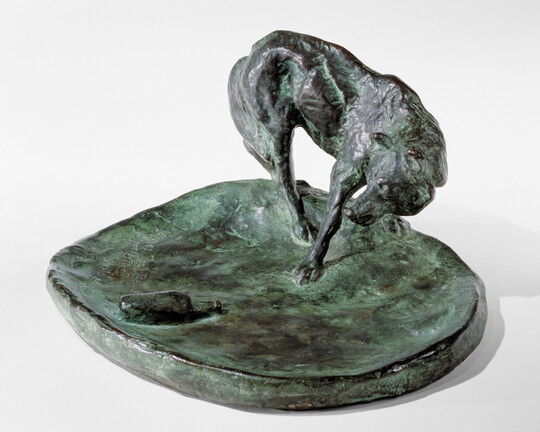













Artwork Images
Photo:
Controls
Counting Coup
Object Details
-
Date
1905
-
Object Type
Sculptures
-
Medium
Bronze
-
Contributors
Cast by Roman Bronze Works
-
Object Format
Lost-wax casting
-
Dimensions
11 x 17 3/4 x 12 1/2 in.
-
Edition
9 estimated lifetime casts
-
Inscriptions
On the upper surface of the base, directly beneath the loins of the horse ridden by the Indian with the tomahawk, approximately 3/4 in. from the outer edge: Copyrighted \ C M Russell \ [skull]
FOUNDRY MARK: On the vertical edge of the base, directly below the right rear leg of the horse ridden by the Indian with the tomahawk, in small capital letters:
ROMAN BRONZE WORKS NY 1905
Directly to the left of the foundry inscription, engraved on the metal: 6
On the underside of the base, in the center, in dark red: #47
-
Collection Name
Amon G. Carter Collection
-
Credit Line
Amon Carter Museum of American Art, Fort Worth, Texas, Amon G. Carter Collection
-
Accession Number
1961.116
-
Copyright
Public domain
Object Description
Three years after he made this sculpture of a hostile encounter between members of two separate Indian Nations, Russell published a short story on the subject titled “The War Scars of Medicine Whip,” which tells the exploits of these figures. The title Counting Coup refers to the number of times someone has proven superiority over an opponent by getting close enough to strike him with a weapon, or “coupstick.”
This particular bronze is a unique example among the earliest versions of the sculpture. All other known copies show a slightly different composition and far less detail and surface texture.
Additional details
Location: Off view
Part of:
Amon G. Carter Collection
See more by Charles M. Russell
Tags
-
What might be the benefits of using bronze to create a sculpture?
What process might an artist follow in creating a bronze sculpture?
How does an artist depict action in a sculpture?
How does a three-dimensional artwork compare to a two-dimensional one?
In what ways can competitions reflect the values of a group?
How do representations of American Indians reflect perceptions? What impact might those representations have on audiences past and present?
-
What is the medium of this artwork? What material has the artist used?
What are the benefits of viewing a sculpture? How would your experience of this work be different if it were two dimensional?
Look closely at this sculpture. Describe the figures in this work. Who do you think the people might be? How can you tell?
Describe the action in the sculpture (encourage students to be very descriptive about all visible action).
The title of the work, Counting Coup, refers to the action of touching an enemy with a weapon or “coup stick” in battle without being injured in the process. How does Russell tell this story in his sculpture? What action is taking place?
What skills or characteristics would a person need to be successful at scoring a coup? Why would it be important to count the number of coups a person attains? What inferences can we make about the traits valued in this competition and by the tribes that counted coup?
Russell did not create this sculpture from an event he witnessed himself. Rather, the practice of counting coup was probably something he read about in a fiction book. What stereotypes of Native Americans does Russell's sculpture perpetuate?
-
Grades Pre-K–3
Students will reflect on a time they played in a game or sport. They should respond to the following questions. What was the most exciting moment of that event for you? How did you feel?
Students will then draw or sculpt an illustration of that moment. Ask them to clearly indicate their emotions in their work of art. As an extension, students may write a story to accompany their work of art.
Grades 4–8
Students will reflect on a time they participated in a competitive event and write a brief essay describing their experience. Students should include the rules and goals of the event. Students should also consider what skills (physical, mental, or social) they developed in preparation for or during the competition. Students may also provide an illustration of a moment from the event.
Grades 9–12
Students will research historical events involving American Indians in the four decades prior to the creation of this sculpture. Encourage students to find sources that also include American Indians’ perspectives of these events. Students may write a brief analysis explaining how this work engages the historical context in which it was created. Students should note details from the sculpture to justify their response.
Share Educator Resources
Amon Carter Disclaimer
This information is published from the Carter's collection database. Updates and additions based on research and imaging activities are ongoing. The images, titles, and inscriptions are products of their time and are presented here as documentation, not as a reflection of the Carter’s values. If you have corrections or additional information about this object please email us to help us improve our records.
Every effort has been made to accurately determine the rights status of works and their images. Please email us if you have further information on the rights status of a work contrary or in addition to the information in our records.
Related Works
-
Indian Family [Woman and child], 1915
Charles M. Russell
Bronze
1961.123
-
Indian Hunter, 1914
Paul Manship
Bronze
1997.3.A
-
The Stampede, 1909
Frederic Remington
Bronze
1961.12
-
Navajo, ca. 1902
Charles M. Russell
Bronze
1961.104
-
Benediction, 1922
Daniel Chester French
Bronze
2005.17
-
Study for a Monument to Walt Whitman, 1919-1920
John Bradley Storrs
Bronze
2001.1
-
Coming Through the Rye, 1902
Frederic Remington
Bronze
1961.23
-
The Negro Looks Ahead, 1940
Richmond Barthé
Bronze on marble base
2007.1
-
To Noses That Read, a Smell That Spells Man, 1920
Charles M. Russell
Bronze
1961.107













